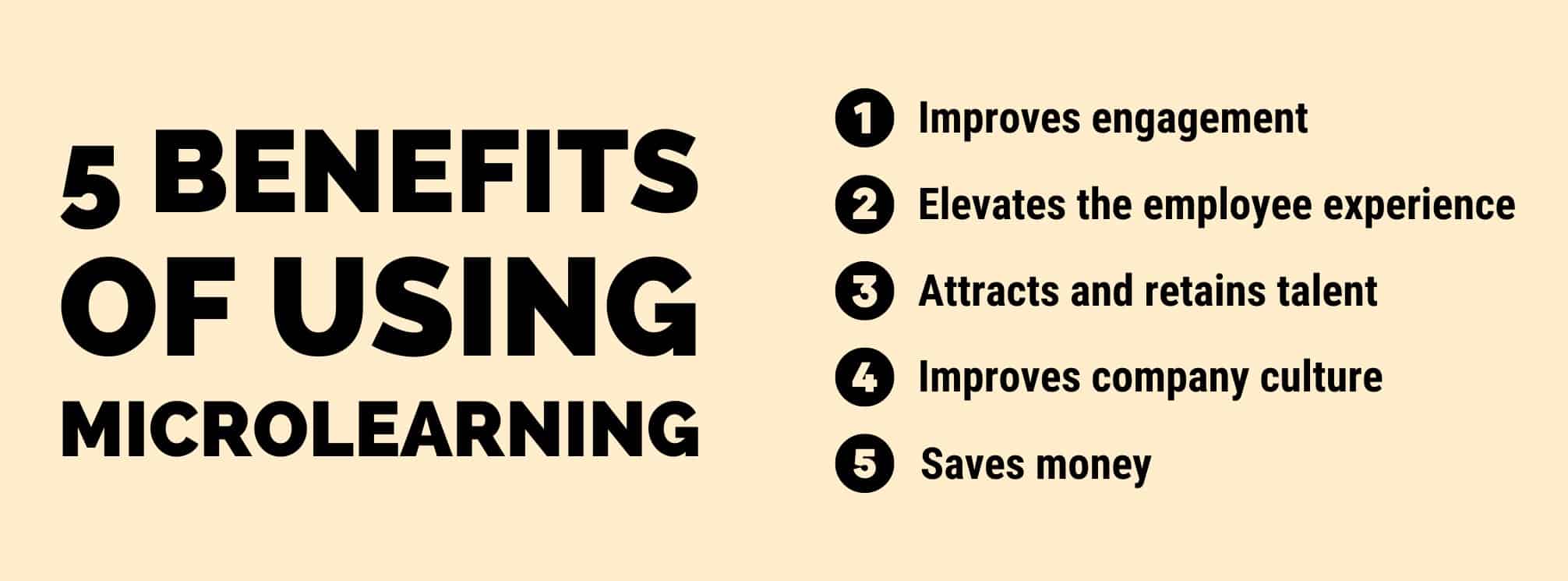
Did you know that upskilling your employees is the key to retaining millennials and Gen Z employees? A Gallup poll found that 87% of millennials prioritize growth and development opportunities when considering where to work. But for many organizations, especially small and mid-sized companies, investing in ongoing training and education can be too costly. The solution? Microlearning.
Microlearning is a type of education where topics are broken into short, digestible units (less than 10 minutes to complete). These can take a variety of forms, including image-based, video content, podcasts, etc. But for something to count as microlearning, it must be short form content that’s educational in nature.
Most microlearning platforms allow the learner to go at their own pace and watch videos as many times as they want.
Many companies have learning management systems (LMS) or training hubs where they host educational materials to help employees with various aspects of their jobs. This can include training employees on hard and soft skills (e.g. communication). And they may rely on things like microlearning content to help upskill and retain their teams.
You might be thinking that microlearning sounds a lot like eLearning, and you’re not wrong. E-learning (or electronic learning) is any kind of training delivered through an electronic device, like laptops, phones, tablets, and so on.
Microlearning could be considered a type of eLearning, but not all microlearning is shared in electronic formats. Some microlearning can be printed, but the most effective type of microlearning is videos. As such, most microlearning is technically e-learning, except it must be short form and easily consumable.
As we’ve mentioned, microlearning content can take many forms. For example:
Companies have a variety of ways to educate their workforce, but what kinds of topics can microlearning cover? The truth is, almost anything can be broken into microlearning campaigns. Here are just a few examples:
[optin-monster slug=”isiekffgatskndkwanri” followrules=”true”]
You might be wondering why you should invest in microlearning compared to longer-form educational programs for your workforce.
The truth is microlearning content leads to better learning and performance outcomes and does so more efficiently than long-form content.
How does it do this? Let’s dive into the 5 main benefits of microlearning.

Microlearning can improve employee engagement by 50%. This Software Advice research also found that it’s not just any learning that drives engagement. It’s specifically short-form content. 58% of employees say they’d be more likely to use their company’s learning resources if the content was shared as multiple, short lessons.
But why is this the case? It’s two-fold:
Digital transformation has opened a lot of doors for us…but the resources and tools we provide to our employees have to be thoughtful. It’s not enough to just provide training to your employees. You have to think about the digital employee experience.
Microlearning videos take all this into account. They are short-form to not waste the employee’s time and they are easy to watch and pull out the key points.
Having a learning and development strategy that leverages microlearning can improve employee focus and improve long-term retention by 80% (RPS Research).
This all comes back to what employees really want: development opportunities. Millennials and Gen Z, in particular, want to develop their skills because they know that the future of work will be highly skills-based.
Investing in ongoing training for your employees is an automatic morale boost. It sends a very clear message that you care about them and their career paths.
But the content you share is also important. It’s important to think about the types of upskilling opportunities you provide and that they are also helpful for your employees and not just for the business. Instead of focusing solely on how you drive more revenue and productivity, think about the skills your employees really want to cultivate so you can offer a healthy variety.
Although you will need to invest in microlearning, there are microlearning platforms (like ours!) that are more affordable than creating your own content. And because this content is “micro,” it’s more affordable than creating longer content.
Then the content itself can also save money. For example:
So, what does it cost to start sharing microlearning content with your employees? That depends on if you choose to create microlearning content in-house and what type of content you want to invest in.
For instance, developing infographics is going to be cheaper than producing videos and podcasts. However, infographics aren’t able to educate employees on all topics, have less depth, and are less effective, especially for complex topics.
We would recommend video training because it’s the most effective. But the cost of creating educational videos in-house can be quite high.
If you’re interested in getting a quote for our microlearning videos, we’d be happy to talk.
What about once you have the microlearning content? What’s the best way to get it into the hands of your employees?
We believe that making your microlearning content accessible for all your employees on a mobile intranet and communications app is key. This ensures that any employee, not just those who work at a desk, can access your educational content. It also means that your videos will be optimized for mobile consumption, which is how the majority of people consume content these days.
That’s why microlearning can be added on to a purchase of our app and intranet bundle. Ready to see it in action? Request a demo today.
[optin-monster slug=”gqorn0natkqgyrtjvr6i” followrules=”true”]